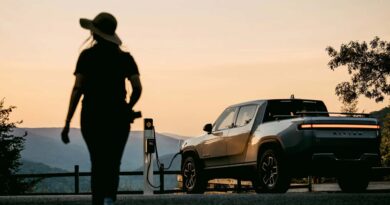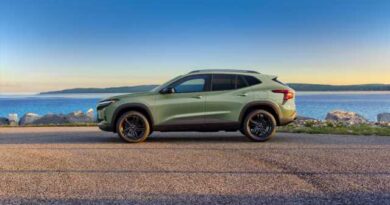5 Myths About Electric Vehicles & Charging Debunked
Whether you’re a new electric vehicle (EV) owner, or considering purchasing one in the near future, there’s a decent chance you’ve come across several myths about living with an EV, especially when it comes to charging. We’ve been scouring social media and EV forums to find some of the biggest misunderstandings among drivers – and we have cleared some of them up for you!
#1: There aren’t enough chargers, and I won’t be able to travel long distances
Partially false. As with so many of these myths, what’s true for some won’t be true for everyone. With the right EV in the right region, long-distance EV road trips are not a problem. Across the United States, there are actually over 100,000 public charging ports1, and no, they’re not just in popular EV states like California, they’re spread across the country, and even as far north as Fairbanks, Alaska. If you want to take a look for yourself, download the handy FLO app to find stations near you.
And there are even more stations to come, President Biden’s Investing in America agenda has committed $24 billion towards the goal of building out a network of over 500,000 public chargers by 2030. $5 billion of funding has already been distributed at the state level through the National Electric Vehicle Infrastructure (NEVI) program, which is on track to install enough high-speed charging stations to cover 75,000 miles of the national highway system in the next two years2.
#2: The electrical grid can’t support mass EV adoption
False. The organizations involved, especially utilities, want to be able to provide EV drivers the electricity they need. While some utilities are further along than others, people in the know say this isn’t a real problem. Consumer Reports, for example, says that it would only take a one percent growth in electricity generation each year to power every car in the U.S. with electrons by 20503.
Frank Fata, Global Head of Utilities at FLO adds that “Demand will not be completely served with new power, the world is learning to save energy, store it, conserve it, and redirect it to meeting growing new demand.”
Utilities have been working for years to prepare for the growing number of EVs, and while more work still needs to be done to support this, it was recently announced that the Department of Energy has allocated nearly $3.5 billion of investments to strengthen grid reliability and resilience across 44 states with a combined $8 billion in private-public investment to bring more than 35 gigawatts of renewable energy online – enough to power about 30 million households5.
#3: It costs the same to charge an EV as a gasoline-powered vehicle
False. We crunched the numbers and found that when we compared the popular Chevrolet Silverado 4WD electric pickup truck with its comparable gas cousin, owners of the EV version would save approximately $1,500 annually on their cost of energy or even more jaw-droppingly approximately $7,500 over the course of 5 years! Here’s how the numbers work out when we use average rates.
This SUV isn’t exactly efficient in gas or electric form, but the point isn’t to find the most efficient EV but to understand the running costs of your vehicle. The EPA rates the 2024 Chevrolet Silverado EV at using 53 kWh per 100 miles6 or just over $9 at the current national average of $0.17 per kWh7.
According to the EPA, the comparable gas model, the 2023 Silverado 4WD requires 5.3 gallons to drive 100 miles8. Gas prices fluctuated in September, but the national average was around $3.85 per gallon10. That means in the gas version of the Silverado it costs $20.41 of gas per 100 miles versus $9.06 in electricity to go the same distance. The average American driver travels about 13,500 miles a year11, which means in this case it would cost you about $1,500 less in energy to drive an EV vs the gas model.
And as a bonus, EVs save on maintenance costs since there’s no need to replace engine oil, timing belts, sparkplugs, and more. The Office Energy Efficiency & Renewable Energy found that the maintenance cost per mile for an EV was $0.06 vs $0.10 for an ICE vehicle12. For the average driver who travels 13,500 miles annually, this would add up to a potential savings of approximately $540 annually or looking longer term that’s $2,700 saved over 5 years.
#4: You have to replace an EV’s battery after 5 years
False. The vast majority of batteries will actually outlast the usable life of a vehicle, according to Geotab, a telematics fleet management company that analyzed 6,300 varying EV battery makes and models13.
Their study showed that, on average, batteries deteriorated about 2.3% yearly, which means if we go back to our Chevrolet Silverado EV example, off the line the pickup has a fully charged range of 450 miles6, after one year of typical driving habits this would bring down its maximum range to approximately 440 miles, a loss of 10 miles, and over five years you would lose about 48 miles of range but still have 402 miles to get you through the day.
If that’s still a concern for you, the major auto manufacturers are offering generous warranties on their batteries to give adopters an extra boost of confidence, just to name a few: GM and Tesla both offer a minimum of 8 years or 100,000 miles (whichever comes first) of coverage17,18.
#5: It takes too long to charge
Mostly false. This is a bit of a subjective situation, so we can’t say for sure that you won’t feel frustrated by the length of time it takes to charge. EV drivers with a charger at home won’t have to spend more than 15-20 seconds as they plug and unplug their vehicle to charge overnight and have a full battery in the morning. When they’re out and about, EV drivers can look for a DC fast charger to refill most of today’s EVs from 0 to 80% in under 40 minutes14. So switching to electric comes also with a change in how you view refueling.
However, it’s what comes next that’s even more exciting to people unsatisfied with that charge time. Ultra-fast charging, like the new FLO UltraTM stations, will offer over 300 kW chargers that can refill that same 0-80% level in 15 minutes or less14,15,16 for next-generation, high-capacity batteries. In many cases, EV chargers are located in places where drivers typically frequent like shopping malls, grocery stores, restaurants, or at work so that the “waiting time” turns into productivity time. Just imagine the scenario of pulling up to your local grocery store, plugging in, grabbing a shopping cart, browsing the aisles and adding items to your cart, checking out, and finally unplugging your vehicle to a 100% battery charge.
Should you make the switch?
There are definitely a few things to learn and become comfortable with when you’re debating the switch from gas to electric. But with the current and rapidly evolving EV charging landscape, EV drivers can enjoy a tremendous amount of benefits: from lower maintenance and energy costs to the convenience of charging at home or while they shop, dine, and play. Combined with the heavy investment that governments, utilities, and auto manufacturers are making in this space, it’ll be a matter of time before you go from “Should I switch?” to “When can I switch?”
References & Disclaimers:
1. Electric vehicle charging station locations. Alternative Fuels Data Center: Electric Vehicle Charging Station Locations. (n.d.). https://afdc.energy.gov/fuels/electricity_locations.html#/find/nearest?fuel=ELEC
2. The United States Government. (2023, June 27). Fact sheet: Biden-Harris Administration driving forward on convenient, reliable, made-in-america national network of electric vehicle chargers. The White House. https://www.whitehouse.gov/briefing-room/statements-releases/2023/06/27/fact-sheet-biden-harris-administration-driving-forward-on-convenient-reliable-made-in-america-national-network-of-electric-vehicle-chargers/
3. Blog: Can the grid handle evs? yes! . CR Advocacy. (2023, May 10). https://advocacy.consumerreports.org/research/blog-can-the-grid-handle-evs-yes/
4. Analyst, S. H. S. V., Director, R. C. P., Director, S. H. C. T. P., & Engineer, D. R. S. (2023, February 23). Can the electric grid handle EV charging?. The Equation. https://blog.ucsusa.org/samantha-houston/can-the-electric-grid-handle-ev-charging/
5. The United States Government. (2023b, October 30). Fact sheet:Biden-Harris Administration Announces Historic Investment to bolster nation’s electric grid infrastructure, cut energy costs for families, and create good-paying jobs. The White House. https://www.whitehouse.gov/briefing-room/statements-releases/2023/10/30/fact-sheetbiden-harris-administration-announces-historic-investment-to-bolster-nations-electric-grid-infrastructure-cut-energy-costs-for-families-and-create-good-paying-jobs/
6. Compare side-by-side. www.fueleconomy.gov – the official government source for fuel economy information. (n.d.). https://www.fueleconomy.gov/feg/Find.do?action=sbs&id=46946
7. U.S. Bureau of Labor Statistics. (n.d.). Average energy prices for the United States, regions, census divisions, and selected metropolitan areas. U.S. Bureau of Labor Statistics. https://www.bls.gov/regions/midwest/data/averageenergyprices_selectedareas_table.htm
8. 2023 Chevrolet Silverado. www.fueleconomy.gov – the official government source for fuel economy information. (n.d.-a). https://www.fueleconomy.gov/feg/bymodel/2023_Chevrolet_Silverado.shtml
9. Month: September 2023. AAA Gas Prices. (2023, September 28). https://gasprices.aaa.com/2023/09/
10. Falling like a feather. AAA Gas Prices. (2023a, September 28). https://gasprices.aaa.com/falling-like-a-feather/
11. Average annual miles per driver by age group. (n.d.). https://www.fhwa.dot.gov/ohim/onh00/bar8.htm
12. FOTW #1190, June 14, 2021: Battery-electric vehicles have lower scheduled maintenance costs than other light-duty vehicles. Energy.gov. (n.d.). https://www.energy.gov/eere/vehicles/articles/fotw-1190-june-14-2021-battery-electric-vehicles-have-lower-scheduled
13. Ev Battery Health: What 6,000 EV batteries tell us. Geotab. (n.d.). https://www.geotab.com/blog/ev-battery-health/
14. Recharge time is based on an average of current market EV models. Recharge time may vary depending on make and model, charger energy transfer speed, temperature, and battery capabilities.
15. Flo Ultra all-in-one DC charger. FLO. (2023, November 22). https://www.flo.com/products/hardware/ultra/
16. Bank, C. I. (2023, April 26). Canada Infrastructure Bank marks its first EV charging investment with a $220 million commitment to Flo®. Cision Canada. https://www.newswire.ca/news-releases/canada-infrastructure-bank-marks-its-first-ev-charging-investment-with-a-220-million-commitment-to-flo-r–849868626.html
17. Chevrolet EV ownership. Chevrolet. (n.d.). https://www.chevrolet.com/electric/faqs/ownership#:~:text=General%20Motors%20warrants%20new%20or,Miles%20(whichever%20comes%20first).
18. Vehicle warranty: Tesla support. Tesla. (n.d.). https://www.tesla.com/support/vehicle-warranty
Source: Read Full Article




